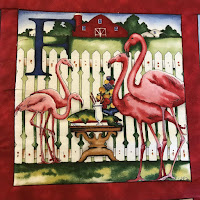This beauty was a Best in Show. It wasn't my favorite in terms of composition, but the colors and technique were awesome.
I've seen this technique in quilting magazines, but in person it was more than awesome. The photo doesn't do it justice. The tulle was nearly invisible, but pulled the entire scene together.
This isn't so much a quilt as a piece of fiber art. I apologize that I neglected to photograph the information about the artist. The photo doesn't adequately capture the 3-dimensional quality of the strands of hair and the flowers on the hat. The quilt is about 4 ft. tall.

The artist hand-painted the face.

This quilt was made by my friend, Deb, who is part of our Thursday-morning quilt group. She won several ribbons for it, which she made with Kaffe Fasset fabrics for her brother, who is constantly going in many directions, as is this quilt!
She fussy-cut the cabbage blocks and quilted them around the leaves.
She strip--pieced the alternating blocks and sashed everything with a black-and-white print.
My friend Carol, also in our Thursday morning group, got lots of oohs and aahs when her llama quilt was previewed at the guild before the show. The quilt was from a kit, but she added her own touches.
One of the ribbons was for her quilting, which enhanced without dominating the quilt. Lovely.
One of my favorite quilts in the show was an embroidered sampler. The quilter started it as a block-of-the month project, but then enhanced it was some wonderful 3-dimensional touches. I am in awe.
Here's another project that went way beyond the original concept to become an award-winning, awesome quilt.

The center of the quilt is a town at night. As you move out from the center, you move out through time (night to day) and through the landscape -- from city to suburbs to the countryside. Each small block is unique. I love this!
Another from my friend, Deb. She got most of these batik fabrics during a trip to Thailand. Each lantern is unique, each linked together by a small chain of three machine-embroidery stitches.

She used a long-arm to quilt narrow matchstick lines horizontally rhtough the neutral background, purposefully allowing the lines to "wobble" to indicate movement, perhaps because of a gentle wind.

And another from Carol -- so different from the llamas! she made this for her son who is a big Batman fan. The general design is a riff on Van Gogh's Starry Night, with the dark city in the lower right corner and Batman surveying the scene. Everyting is individually pieced. What a thrill to see this quilt created from beginning to end.

Every one of us makes our quilts for different reasons, many as a gift of love to someone else. This Tree of Life quilt was made as a remembrence to honor those who lost their lives at the Tree of Life Synacogoge in Pittsburgh just months before the quilt show. The artist's words tell it all.















































